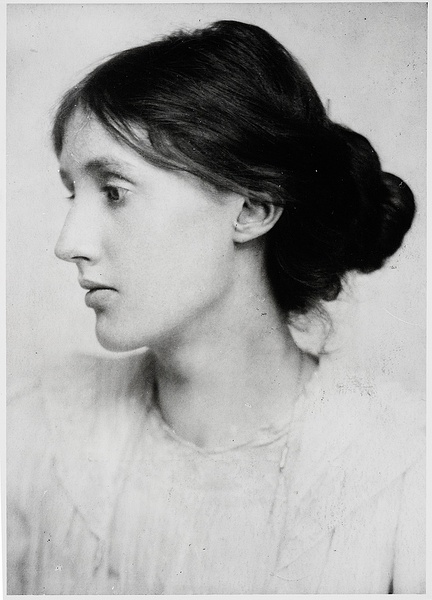我亲爱的朱利安:弗吉尼亚·伍尔夫写给年轻诗人的信
当相对年轻的朱利安决定从事诗歌写作时,他的阿姨在这封以前未曾发表过的信中提供了一种既支持又冷静观之的意见。它是伍尔夫用紫色的墨水写成的,日期只是简单的“星期一”。信的全文是:“星期一。我亲爱的朱利安,我非常喜欢这首诗。我认为应把它流传出去。你是什么时候写的?它会成为我在罗德麦尔的新图书馆之收藏的重要一本。但这就是说——请在明天(星期五)七点半赶到那里,因为我们想让你载着我们和莱茜儿去餐馆。”

Document: Woolf’s Letter to a Young Poet
Virginia Woolf, who had no children of her own, famously directed much of her maternal energy to the offspring of Vanessa Bell, her sole full sister and long-standing dust-jacket designer. Vanessa’s oldest son Julian was Woolf’s particular favorite. He was named for Virginia’s brother Julian Thoby Stephen, who died of typhoid at the age of twenty-six on a trip to Greece. Thoby, as he was called, inspired Woolf to write Jacob’s Room, in which she rendered the protagonist chiefly through others’ memories; the pain of his loss was such that, even in fiction, she strained against summoning him by direct account.
When the younger Julian decided to pursue poetry, his aunt Virginia offered the blend of succor and static seen in this previously unpublished letter. Composed in Woolf’s signature purple ink, and dated simply “Thursday,” the letter reads in full: “Thursday. My dear Julian. I like the poem very much. It still wants CURRENCY I think. When did you write it? It shall be the cornerstone of my new library at Rodmell. But this is to say—please be here 7:30 sharp tomorrow (Friday) as we want you to drive Rachel & us to a restaurant.”
The letter likely dates to November 1929. Woolf refers in her diary on November 30 to a dinner party at the Red Lion with “Julian & Rachel.” (Rachel was Rachel MacCarthy, daughter of writer Molly and editor Desmond MacCarthy.) Rodmell is the location of the Woolfs’ cottage, Monk’s House, which the couple inhabited from 1919 until Virginia’s death in 1941. The poem she refers to is probably Julian’s “Chaffinches,” published in the Songs for Sixpence series of a small Cambridge publisher, a copy of which is indeed in the Woolfs’ library at Washington State University in Pullman.
Woolf’s blunt criticism of Julian’s poem, her dig that it might be mere youthful experiment, the leavening (yet peremptory) dollop of praise, and the call to chores all typify the complexity of their relationship. The following year, after Julian’s first book of poems came out, Virginia declared, “He is no poet.” She once described her relationship to him as “half sister, half mother, and half (but arithmetic denies this) the mocking stirring contemporary friend.” Though she frequently expressed criticism of his writing, she ultimately published one of his books at the Hogarth Press.
But Julian’s career would be short-lived. Like his namesake Thoby, he did not see his thirtieth birthday. In his late twenties he took up the Republican cause in the Spanish Civil War, enlisting as an ambulance driver, and was killed at the Battle of Brunete in 1937. Virginia committed suicide in 1941; this year marks the seventieth anniversary of her death.

弗吉尼亚·伍尔夫没有自己的孩子,却很好地把大部分母爱都分给了凡妮莎·贝尔的后代,凡妮莎是她唯一的亲姐姐与长期的书籍护封设计者。凡妮莎的大儿子朱利安是伍尔夫最喜爱的。他得名于弗吉尼亚的哥哥朱利安·索比·斯蒂芬,26岁时,他在去希腊的旅途中死于伤寒。他们叫他索比,是他激发了伍尔夫创作《雅各的房间》,在这本书中,她主要通过别人的记忆来渲染主人公:失去他的悲痛如此沉重,即使在小说中,她也尽力不用直接叙述来召唤他。
当相对年轻的朱利安决定从事诗歌写作时,他的阿姨在这封以前未曾发表过的信中提供了一种既支持又冷静观之的意见。它是伍尔夫用紫色的墨水写成的,日期只是简单的“星期一”。信的全文是:“星期一。我亲爱的朱利安,我非常喜欢这首诗。我认为应把它流传出去。你是什么时候写的?它会成为我在罗德麦尔的新图书馆之收藏的重要一本。但这就是说——请在明天(星期五)七点半赶到那里,因为我们想让你载着我们和莱茜儿去餐馆。
这封信很可能是1929年11月写的。伍尔夫在日记种提到11月30号,她曾和“朱利安与莱茜儿”(莱茜儿指的莱茜儿·麦卡希,作家莫莉与编辑德斯蒙德·麦卡锡的女儿)去参加在红狮举行的晚宴。罗德麦尔是伍尔夫的别墅——修道之屋(Monk’s House)所在地,从1919年到1941年弗吉尼亚去世,他们夫妇一直住在那里。她所指的那首诗很可能是朱利安的“苍头燕雀”,发表在一个很小的剑桥出版社的“六便士之歌”丛书里。事实上,此书在华盛顿洲立大学普尔曼分校的伍尔夫图书馆里有一副本。
伍尔夫对朱利安诗歌的评论是直言不讳的,她说它也许只是年轻人的实验作品,这种潜移默化,毫不贸然为之的赞美以及对杂事的提及全都显示了他们关系的复杂性。第二年,朱利安的第一本诗集出版之后,伍尔夫断言:“他没有诗才”。她曾把自己与朱利安的关系描述为“半是姐姐,半是母亲,半是(但在算数上不成立)嬉笑怒骂的同代好友)。尽管她经常会对他的创作提出批评,但最终她还是在自己的霍加斯出版社出版了他的一本书。
但朱利安的写作事业也是短命的,他步同名的索比舅舅的后尘,没能活到30岁。二十八九岁时,他在西班牙内战中为共和事业而战,当了一名急救车司机,并在1937年的布鲁内特之战中不幸身亡。弗吉尼亚也在1941年自杀了:今年是她逝世七十周年的纪念日。





 京公网安备 11010802032529号
京公网安备 11010802032529号